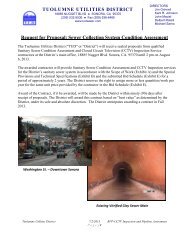Historic Resource Evaluation Project - Tuolumne Utilities District
Historic Resource Evaluation Project - Tuolumne Utilities District
Historic Resource Evaluation Project - Tuolumne Utilities District
Create successful ePaper yourself
Turn your PDF publications into a flip-book with our unique Google optimized e-Paper software.
and is historic in its own right, or affects but small segments of the whole. In other cases<br />
pipelines have been laid in the historic ditch beds, not adversely impacting the<br />
archaeological ditch. In addition, it appears that the presence of the dual systems—the<br />
archaeological ditches and the active canals—may increase the overall significance of the<br />
systems, as they may answer questions important in the history of ditch engineering.<br />
As noted in an earlier survey:<br />
Based upon initial inspection….while it is commonly held that the ditch<br />
system is over 150 years of age, it appears that the majority of the ditches<br />
are late 19 th or early 20 th century re-engineered conveyances, and that few<br />
areas actually date to the 1850s. This is very evident along portions of the<br />
Columbia, Shaw’s Flat, Phoenix, Algerine, and San Diego systems where<br />
long-abandoned earth bermed ditches parallel the existing ditches.<br />
Archival records that survive are scarce, but suggest that when Pacific Gas<br />
and Electric Company (and Sierra and San Francisco Power) reworked the<br />
ditches they abandoned some of the earlier segments for newer, better<br />
engineered canals (Davis-King 2003).<br />
This survey also identified parallel ditches along the Eureka, Roach’s Camp, Matelot, and<br />
Montezuma ditches. While many were no doubt altered or realigned in the 20 th century,<br />
it appears likely that others were altered in the 1860s and 1870s by the <strong>Tuolumne</strong><br />
Hydraulic Mining Company (THMC), taking water to their various claims, and the<br />
TCWC during the late 1880s-1890s hard-rock mining boom. Their evaluation under<br />
Criterion A, therefore, assumes that their eligibility dates to the earliest period of their<br />
operation, as changes over time are important in their own right.<br />
<strong>Historic</strong>ally, the ditch system was directly associated with Sierra Nevada mining and<br />
hydroelectric power industries, land settlement, community development, and logging,<br />
and played a substantial part in the economic and corporate development of the region.<br />
The landscape is strongly evocative of the accomplishment of the early ditch and flume<br />
builders and the challenges they faced, particularly in the unchanged higher elevations<br />
and in cutting through the limestone belt in the lower, as they meander around hillsides,<br />
drop down steep slopes, or course across the landscape.<br />
NATIONAL REGISTER OF HISTORIC PLACES EVALUATION<br />
Under the NRHP a resource is considered to be “historically significant” if it meets the<br />
following criteria for listing on the NRHP:<br />
The quality of significance in American history, architecture, archeology,<br />
and culture is present in districts, sites, buildings, structures, and objects of<br />
State and local importance that possess integrity, and:<br />
A. That are associated with events that have made a significant<br />
contribution to the broad patterns of our history; or<br />
Foothill <strong>Resource</strong>s, Ltd. 4.5 TUD Ditch Sustainability <strong>Project</strong><br />
Francis Heritage, LLC<br />
<strong>Historic</strong> <strong>Resource</strong> <strong>Evaluation</strong> Report




